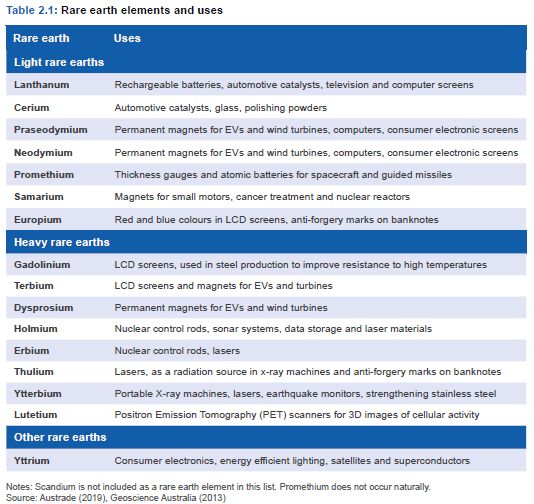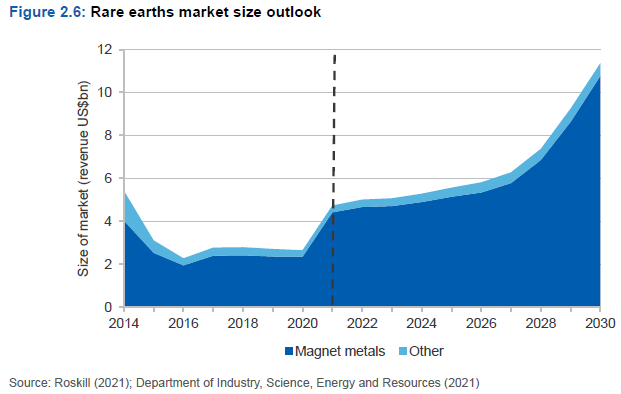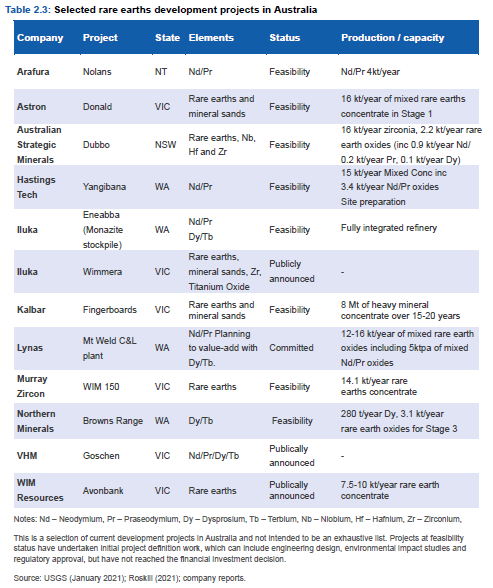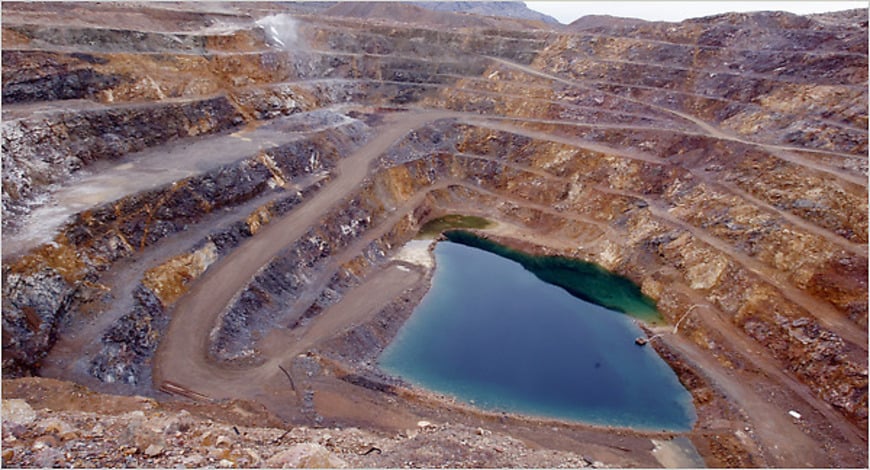The global demand for rare earth elements increased drastically over the past two decades, in line with its increasing applications in high-end technologies. Rare earth elements are a group of 17 metals made up of 15 lanthanides, plus scandium and yttrium. According to Geoscience Australia, its uses range from routine technologies such as lighter flints, glass polishing mediums, and car alternators, to high-end technology like lasers, magnets, batteries, or fiber-optic telecommunication cables. One of the fastest growing and high-value markets for rare earth is magnets, with rare earth element permanent magnets considered to be three times stronger than conventional magnets and only one-tenth of their size. Permanent rare earth magnets are used extensively in low-emissions technologies like wind turbines and electric vehicles. Other futuristic applications could be high-temperature superconductivity, safe storage and transport of hydrogen for a post-hydrocarbon economy, and as a solution for environmental global warming and energy efficiency issues.

According to a report titled “Outlook for Selected Critical Minerals 2021” by the Office of the Chief Economist, Australia, the consumption of rare earth are projected to grow globally at 4.0% per annum over the next 10 years to 2030, with magnet production to grow by 6.2% per annum, driven by the strong take-up of low carbon emissions technologies. The outlook for rare earth elements varies considerably and depends primarily on their end-use. According to the report by the Chief Economist, Neodymium and praseodymium, in particular, are expected to experience market shortfalls towards the end of the decade. The neodymium-praseodymium market is projected to grow by 35% over the outlook period to 2030. As most producers market mixed oxide, there is a premium for the separated products. Consequently, producers are looking at ways to extract the most valuable rare earth within their total mine extraction. Thus the economics of extraction is increasingly reliant on the ‘magnet elements’. The compound average annual growth for the price of magnet metals over the next 10 years to 2030 (in real terms) is projected to be 8-9%. The global rare earth market was valued at around US$2 billion in 2020 and is forecast to grow to around US$12 billion by 2030.

Australia is ranked sixth in the world in terms of rare earth resources, with a 3.4% share of world resources(economically demonstrated resource of 4,100 kt as of Jan 2021), and fourth in terms of production with a share of 9.4% of world production (2020 Production of 23.7 kt). Over the forecast period (to 20230) Australia’s mined rare earth element production is forecast to grow by 9.1% annually, driven by increased production planned from Lynas Rare Earths (ASX: LYC). Lynas is the largest supplier of refined rare earth (mixed oxide products) outside of China. Processing is currently undertaken in Malaysia, although the first stage of cracking and leaching may take place in Western Australia by mid-2023. Lynas is also looking for additional extraction of dysprosium and terbium. Iluka Resources (ASX: ILU) is also developing its Eneabba tailings operation that contains rare earth in the form of monazite residues. The Eneabba refinery will be fully integrated, producing both light and heavy separated rare earth oxides and capable of processing feedstocks from Iluka's portfolio and a range of third-party suppliers. This positions Eneabba and Australia as strategic hubs for the downstream processing of these critical minerals.

Disclaimer: Ace Investors Pty Ltd (ABN 70 637 702 188) authorized representative of Alpha Securities Pty Ltd (AFSL No.303575). Ace Investors has made all efforts to warrant the reliability and accuracy of the views and recommendations articulated in the reports published on its websites. Ace Investors research is based on the information known to us or which was obtained from various sources which we believed to be reliable and accurate to the best of its knowledge. Ace Investors provides only general financial information through its website, reports and newsletters without considering financial needs or investment objectives of any individual user. We strongly advocate that you seek advice, with your financial planner, advisor or stock broker, the merit of each recommendation before acting on any recommendation for their own specific financial circumstances and realize that not all investments will be suitable for all subscribers. To the scope permitted by law, Ace Investors Pty Ltd excludes all liability for any loss or damage arising from the use of this website and any information published (including any indirect or consequential loss, any data loss or data corruption). If the law prohibits this exclusion, Ace Investors Pty Ltd hereby limits its liability, to the scope permitted by law to resupply of the services. The securities and financial products we study and share information on, in our reports, may have a product disclosure statement or other offer document associated with them. You should obtain a copy of these before making any decision about acquiring any security or product. You can refer to our Financial Services Guide.

